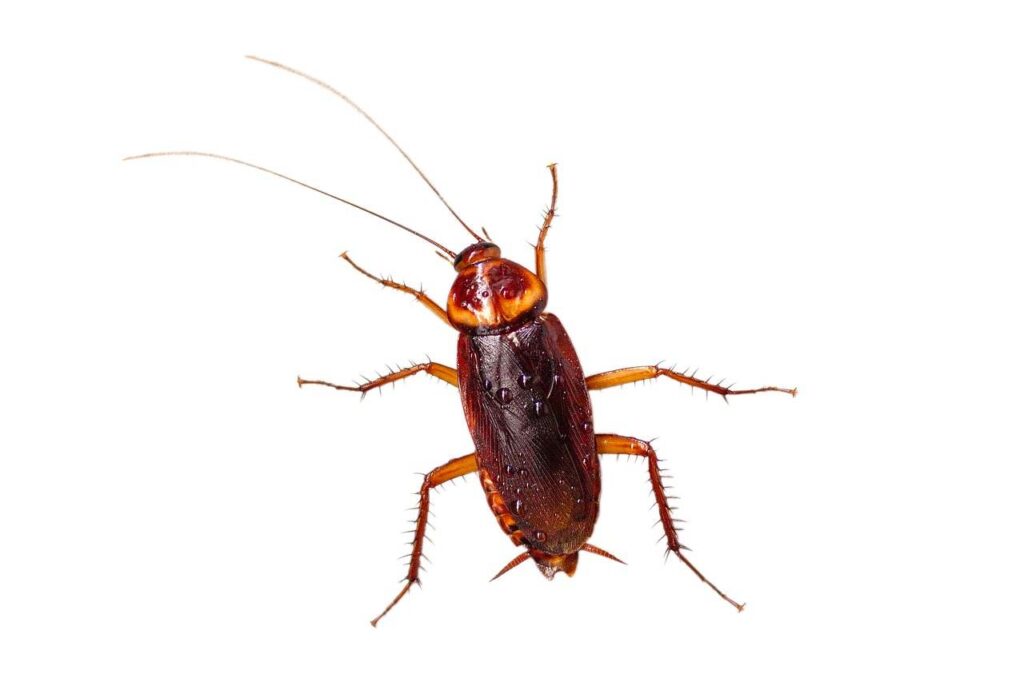American cockroaches are one of the most prominent types of pests in the U.S., so chances are, you have witnessed these rather large roaches at least once in your lifetime either around or in your property, especially in dark, humid places, such as the boiler room, basement, laundry room, kitchen, or bathroom, where they prefer to live. You may have even witnessed these enormous bugs take flight, which typically occurs when they become scared, which can be especially alarming.
What are American Cockroaches?
American cockroaches are large, reddish-brownish bugs that resemble typical household roaches; however, at 1.4 to more than 2 inches long, they are much larger and faster, which makes them more intimidating. They also have a yellow band behind their head and wings that enable them to fly, which also sets them apart from other roaches.
The American cockroach typically thrives outdoors under mulch and in flowerbeds where their typical diet consists of small insects, leaves, fungi, algae, and even small wood particles, which is why they are also sometimes found living in trees and referred to as palmetto bugs. In many cities, they can also be found living in sewer and drain systems where they feed on decaying matter.
However, when their resources are low, they will enter a property via gaps under the doors or around basement and garage windows in search of food and water. Once inside, they will feed on any water or food underneath cabinets, in drains, and under appliances. They will also feed on any food spills, crumbs, or scraps left on the floor, as well as any available pet food.
Do American Cockroaches Pose any Risks?
American cockroaches can bite; however, research shows that it rarely happens, and in cases when they do bite, it is typically only an issue if the area is allowed to become infected.
American cockroaches are also known to carry germs on their bodies and legs from sewage and decaying matter, which poses the biggest threat to humans because these germs can be transferred onto surfaces and foods, which have been shown to cause diseases, such as cholera, typhoid fever, and more.
Treating American Cockroaches
Treating your American cockroach problem begins by sealing all gaps, cracks, and other openings around your property to help keep cockroaches from entering. You should also remove all open food and water sources to avoid attracting cockroaches, which can cause an infestation. Removing sources of shelter, such as paper clutter, and vacuuming regularly will also help deter cockroaches.
In the meantime, be on the lookout for signs of American cockroaches, such as small, dark, droppings similar to mouse droppings but without the pointed ends. You may also notice blackish-brown or reddish 8 mm long egg capsules stuck to various surfaces near sources of food, such as near cabinets or under appliances; however, American cockroaches are also known to hide their eggs storage items in sheds and garages.
An American cockroach egg capsule can contain up to 16 eggs, which can develop into adults in just 5 1/2 months, provided the conditions are right. Therefore, if you spot any signs of American cockroaches, it is best to address it early.
The earlier the issue is treated, which the technician can do using granular baits, residual insecticides applied to hiding places and around the exterior to help prevent cockroaches from hiding or coming inside, and more, the less chance you have of developing an infestation, which can require more costly, time-consuming treatments down the road. Once the property becomes infected with American cockroaches, it will require regularly scheduled monitoring and treatments to successfully remedy the issue.

